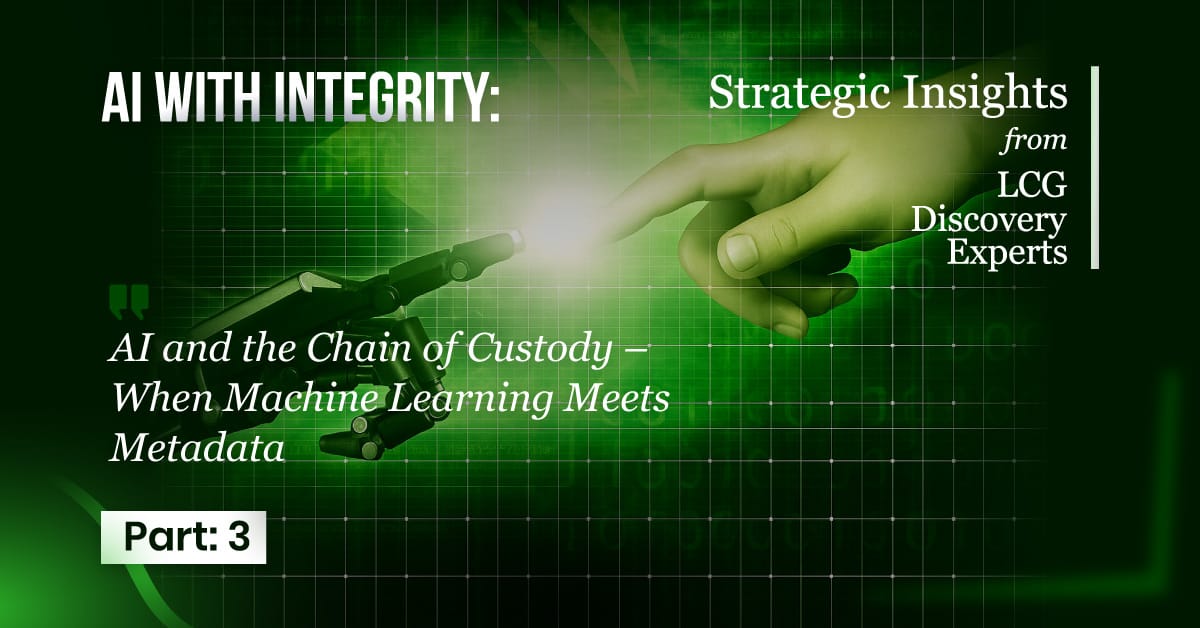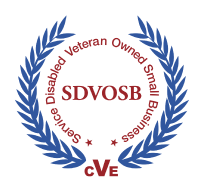AI and the Chain of Custody: When Machine Learning Meets Metadata
Contributed by Thane M. Russey, VP, Strategic AI Programs
Series context. This installment builds directly on Part 1 (“AI as Evidence”) and Part 2 (“From Predictive to Prescriptive”) in our AI with Integrity series. It focuses on how AI-powered tools intersect with metadata, chain of custody, and forensic soundness, and what legal teams must do to stay defensible. [10]
Why metadata is evidence
In digital matters, metadata carries the “who/what/when/where/how” that authenticates a file and anchors timelines. U.S. courts require proponents to show that evidence “is what [they] claim it is” under Federal Rule of Evidence 901, and in many cases allow self-authentication of records generated by an electronic process when a qualified person certifies the system’s accuracy (FRE 902(13) and 902(14)). [1][2] International guidance reinforces the point: ISO/IEC 27037 defines defensible handling across identification, collection, acquisition, and preservation, with a documented chain‑of‑custody record linking handlers and state changes over time. [3] NIST continues to emphasize the importance of forensically sound conditions, validated methods, controlled handling, and careful documentation before, during, and after acquisition. [4]
LCG perspective. In our broader thought leadership on the justice system, we’ve cautioned that efficiency pressure (and insurance-driven cost controls) can erode forensic rigor, especially around the chain of custody. That tension hasn’t gone away simply because AI has arrived. [5][6]
How AI and modern platforms change (or create) metadata
AI appears in today’s eDiscovery stacks in three primary areas: processing, analytics/classification, and export/production. Each stage can transform metadata or add machine-derived fields that later appear in your review set and load files.
- Processing & normalization. Cloud platforms extract text, perform OCR, parse conversation threads, and normalize formats. They maintain extensive document metadata fields (e.g., conversation identifiers, custodian information, source platform indicators) that were not present in the raw file but are now associated with it in the case record. [7]
- Analytics & machine classifications. Features such as near‑duplicate detection, email threading, and theming compute machine-generated attributes (e.g., inclusiveness or “representative” flags) that shape what a reviewer sees and what gets exported. These are derived values, metadata created by your toolchain, not properties of the original file. [7]
- Export & production packaging. When you export review sets, platforms let you select native, image, text, and load-file fields. Options to include related conversation items, redacted PDFs, or deduplicated families can alter what is sent out of the system and may add workflow logs (warnings/errors) to the package, again, adding more metadata. [8]
Across platforms, load‑file specifications and field maps govern how metadata is carried forward. Get them wrong, and what arrives in opposing counsel’s database won’t match your story. [9] Even seemingly benign steps, such as OCRing a scan, converting to PDF, or stitching short message threads, can introduce errors, drop fields, or reset application-level properties (e.g., PDF producer, creation date). Authoritative references, therefore, urge teams to separate native evidence and machine-derived context, and to document both. [10][17]
Why “forensic soundness” still rules in an AI world
AI can accelerate review and triage, but collection and preservation must still follow forensic best practices:
- Validate the tools you rely on. SWGDE’s Minimum Requirements for Testing Tools establishes baseline validation expectations and references NIST’s CFTT methodologies. If you’ll cite analytics in court (e.g., dedupe or threading decisions), know the tool’s limits and your lab’s validation history. [11][14]
- Acquire with integrity. SWGDE’s Best Practices for Computer Forensic Acquisitions and Best Practices for Remote Collection of Digital Evidence from an Endpoint reiterate: minimize changes to source data, hash-acquired data, and thoroughly document the process, including agent versions and any deviations. [12][13]
- Log every transformation. If AI-assisted steps (classification, redaction, transcription, translation) create derivative items, treat them as secondary evidence with their own provenance. This aligns with Sedona’s authentication guidance. [10]
Five standard failure modes we see (and how to avoid them)
- Admin Console Exports as “Collections” → AI Data Ingestion Shortcuts
- Traditional risk: IT exports mailboxes or SharePoint content without forensically sound methods, losing hash values and metadata.
- AI parallel: Organizations feed AI models raw exports or convenience datasets without validating provenance. That undermines defensibility because AI outputs rely on incomplete or altered source material.
- Avoidance: Apply validated acquisition pipelines, maintain data lineage, and capture hashes/version logs at each stage to ensure AI systems can be audited [12].
- Silent Deduplication → Hidden Data Bias in AI Training
- Traditional risk: Deduplication hides file versions that may affect case timelines.
- AI parallel: Data preprocessing (e.g., deduplication, normalization) can eliminate edge cases or underrepresented classes, introducing bias. For example, fraud detection models may underrepresent rare but critical behaviors.
- Avoidance: Preserve pre-processed datasets, log deduplication rules, and retain documentation of feature-selection algorithms to defend against claims of bias or omission [7].
- Threading that Drops Context → AI Summarization Without Provenance
- Traditional risk: Email “inclusiveness” flags drop messages that still contain unique headers or metadata.
- AI parallel: Large language models (LLMs) and AI summarizers strip context in the name of efficiency, producing outputs that lack full traceability to the original inputs. In legal matters, that can create gaps in spoliation or intent analysis.
- Avoidance: Maintain complete conversation histories, log exclusion criteria, and adopt AI systems that provide traceable output-to-input mapping [7].
- OCR and Translation Drift → AI Hallucination and Model Error Rates
- Traditional risk: Text extraction errors propagate into downstream review.
- AI parallel: LLMs and machine translation systems can misinterpret, mistranslate, or hallucinate. Without documenting known error rates, those mistakes ripple into compliance, privilege review, or investigative analytics.
- Avoidance: Retain source artifacts (scanned images, audio files), log error rates, and perform spot-check audits of AI outputs. Courts and regulators increasingly demand this under Daubert reliability standards [10].
- Short Message Entropy → AI Multi-Platform Confusion
- Traditional risk: Slack, Teams, iMessage, and WhatsApp all use different timestamps and metadata, which can scramble authorship when stitching threads.
- AI parallel: When multi-platform chat data is fed into AI analytics or review tools, inconsistent timestamp conventions can distort timelines or authorship attribution. That undermines both investigations and defensibility.
- Avoidance: Maintain an authoritative metadata schema, align time zones and field mappings, and disclose platform-specific handling rules in AI-assisted reviews [15].
Anchoring AI use to governing standards (so you can defend it)
- FRE 901/902: Be ready to show how your system produces accurate results and certify both the collection process and any digital copies under 902(13) and 902(14). If AI processes created or filtered what you produced, that should be included in your certification narrative. [1][2]
- ISO/IEC 27037 (+ 27041/27042): Map your SOPs to the ISO series so your documentation tracks identification → collection → acquisition → preservation, then analysis/interpretation. [3][17]
- SWGDE + NIST CFTT: Maintain current tool validations, especially after version upgrades and when enabling AI-assisted features. [11][14]
- NIST AI RMF (and the Generative AI Profile): Treat AI features in your evidence pipeline as AI systems subject to risk controls, govern data provenance, measure performance, manage bias, and document decisions. [16]
A defensible playbook: “Two-track evidence packaging”
To reconcile speed with defensibility, we recommend two synchronized evidence tracks:
Track A, The Evidentiary Set (immutable):
- Forensically acquired natives (or bit-for-bit images), with hashes logged at each transfer.
- Chain‑of‑custody ledger capturing handler, time, location, tool/version, and reason for access.
- Read-only storage with access controls and audit logs.
- Container formats and hashing per SWGDE best practices. [12]
Track B, The Analytical Set (derivative/AI-assisted):
- Processing/normalization outputs, OCR text, threading/near‑duplicate analytics, and machine tags.
- Review‑platform load files and export manifests; warnings/errors CSVs preserved alongside.
- Model/feature documentation: which analytics ran (e.g., inclusiveness), configuration, version/date, and any sampling/QC results.
- An AI‑risk register aligned to NIST AI RMF (intended use, known limitations, monitoring). [7][8][16]
Production strategy. Produce from Track B for efficiency, but stipulate that Track A is your system of record. If a dispute arises, you can recompute hashes, re-export with different options, or rerun analytics without compromising authenticity.
What your chain‑of‑custody log should add in the AI era
Augment your standard chain‑of‑custody with the following AI-aware fields (many are already encouraged in SWGDE guidance for remote and traditional acquisitions):
- Source identifiers (device, account, tenant, custodian) and legal authority to collect.
- Tool inventory with version/build and validation reference (SWGDE/NIST CFTT).
- Transformations list (OCR, translation, threading, dedupe, clustering, enrichment).
- Derived‑item mapping (from native → processed → produced), with Bates/control numbers and hash lineage.
- Export profile used (options, date/time, user, warnings/errors files).
- Exception handling (decryption failures, corrupted items, processing errors). [13][12]
Quick checklist: 9 guardrails for AI-assisted collections
- Decide what’s evidence vs. analytics before you collect; preserve both.
- Acquire forensically (hashes, write‑blocking, documentation). [12]
- Validate your stack (and re‑validate after upgrades). [11][14]
- Record every AI/ML transformation with parameters and versions. [7][10]
- Keep pre-dedup and non-inclusive items accessible for challenge scenarios. [7]
- Use authoritative field references for short messages and collaboration data. [15]
- Design exports are deliberately created (manifest, load file fields, and warnings/errors are saved). [8][9]
- Map SOPs to ISO/IEC 27037 and Sedona authentication guidance. [3][10]
- Adopt NIST AI‑RMF controls for AI features in your pipeline. [16]
Final thought
AI is an accelerator, not an alibi. It can help you find the signal faster, but it also adds layers of machine-generated context that must be documented, validated, and explained in human terms. If you maintain a clean split between evidence and analytics, and if your chain of custody tells a complete story from native to produced, you’ll keep the benefits of AI without sacrificing admissibility or trust. That’s the heart of AI with Integrity. [16]
References (endnotes)
[1] Federal Rules of Evidence 901, Authenticating or Identifying Evidence (Cornell LII). https://www.law.cornell.edu/rules/fre/rule_901
[2] Federal Rules of Evidence 902, Evidence That Is Self‑Authenticating, including 902(13) and 902(14) (Cornell LII). https://www.law.cornell.edu/rules/fre/rule_902
[3] ISO/IEC 27037:2012, Information technology, Security techniques, Guidelines for identification, collection, acquisition and preservation of digital evidence (ISO). https://www.iso.org/standard/44381.html
[4] NIST SP 800‑101 Rev. 1, Guidelines on Mobile Device Forensics (NIST CSRC). https://csrc.nist.gov/pubs/sp/800/101/r1/final
[5] National Institute of Justice, Digital Evidence in the Courtroom: A Guide for Law Enforcement and Prosecutors (Special Report). https://www.ojp.gov/pdffiles1/nij/211314.pdf
[6] NIST SP 800-86, Guide to Integrating Forensic Techniques into Incident Response (NIST CSRC). https://csrc.nist.gov/publications/detail/sp/800-86/final
[7] Microsoft Purview eDiscovery (Premium) documentation: Document metadata fields; Near‑duplicate detection; Email threading; Analytics overview. https://learn.microsoft.com/en-us/purview/edisc-ref-document-metadata-fields | https://learn.microsoft.com/en-us/purview/ediscovery-near-duplicate-detection | https://learn.microsoft.com/en-us/purview/ediscovery-email-threading | https://learn.microsoft.com/en-us/purview/ediscovery-analyzing-data-in-review-set
[8] Microsoft Purview eDiscovery export options and package contents: Export items from a review set; Export case data overview; Export reference and output fields. https://learn.microsoft.com/en-us/purview/edisc-review-set-export | https://learn.microsoft.com/en-us/purview/ediscovery-exporting-data | https://learn.microsoft.com/th-th/purview/edisc-ref-export
[9] Relativity load file specifications and field mapping references: Server 2024 load file specifications; RelativityOne Import/Export load file specs. https://help.relativity.com/Server2024/Content/Relativity/Relativity_Desktop_Client/Importing/Load_file_specifications.htm | https://help.relativity.com/RelativityOne/Content/Relativity/Import_Export/Import_Export_Load_file_specifications.htm
[10] The Sedona Conference, Commentary on ESI Evidence and Admissibility, Second Edition. Publication page and PDF. https://www.thesedonaconference.org/publication/Commentary_on_ESI_Evidence_and_Admissibility | https://www.thesedonaconference.org/sites/default/files/publications/ESI%20Evidence%20and%20Admissibility%20October%202020.pdf
[11] SWGDE, Minimum Requirements for Testing Tools Used in Digital and Multimedia Forensics. PDF and OSAC registry entry. https://www.swgde.org/wp-content/uploads/2024/04/2024-03-07-SWGDE-Minimum-Requirements-for-Testing-Tools-Used-in-Digital-and-Multimedia-Forensics-18-Q-001-2.1.pdf | https://www.nist.gov/osac/standards-library/swgde-18-q-001-10
[12] SWGDE, Best Practices for Computer Forensic Acquisitions. PDF and OSAC registry entry. https://www.swgde.org/wp-content/uploads/2024/03/2023-06-15-SWGDE-Best-Practices-for-Computer-Forensic-Acquisitions-17-F-002-2.0.pdf | https://www.nist.gov/osac/standards-library/swgde-17-f-002-20
[13] SWGDE, Best Practices for Remote Collection of Digital Evidence from an Endpoint (2025). Publication page and PDF. https://www.swgde.org/documents/published-complete-listing/22-f-003-best-practices-for-remote-collection-of-digital-evidence-from-an-endpoint/ | https://www.swgde.org/wp-content/uploads/2025/03/2025-03-04-Best-Practices-for-Remote-Collection-of-Digital-Evidence-from-an-Endpoint-22-F-003-2.0.pdf
[14] NIST Computer Forensics Tool Testing (CFTT) Program overview and methodology. https://www.nist.gov/itl/ssd/software-quality-group/computer-forensics-tool-testing-program-cftt | https://www.nist.gov/itl/ssd/software-quality-group/computer-forensics-tool-testing-program-cftt/cftt-general-0
[15] EDRM Short Message Metadata Primer 1.0 and Relativity Short Message Format (RSMF) reference. https://edrm.net/2023/07/edrm-releases-new-resource-edrm-short-message-metadata-primer-1-0/ | https://complexdiscovery.com/wp-content/uploads/2023/07/EDRM-2023-Short-Message-Metadata-Primer-Public-Comment-Version.pdf | https://help.relativity.com/RelativityOne/Content/System_Guides/Relativity_Short_Message_Format/Relativity_short_message_format.htm
[16] NIST AI Risk Management Framework resources: AI RMF 1.0 publication page and PDF, Generative AI Profile. https://www.nist.gov/publications/artificial-intelligence-risk-management-framework-ai-rmf-10 | https://nvlpubs.nist.gov/nistpubs/ai/NIST.AI.100-1.pdf | https://www.nist.gov/itl/ai-risk-management-framework
[17] ISO/IEC 27041:2015 and ISO/IEC 27042:2015, Incident investigation and analysis guidance (ISO). https://www.iso.org/standard/44405.html | https://www.iso.org/standard/44406.html
This article is for general information and does not constitute legal advice. For matter-specific guidance or to request LCG’s Chain‑of‑Custody & AI Validation playbook, contact our team.







